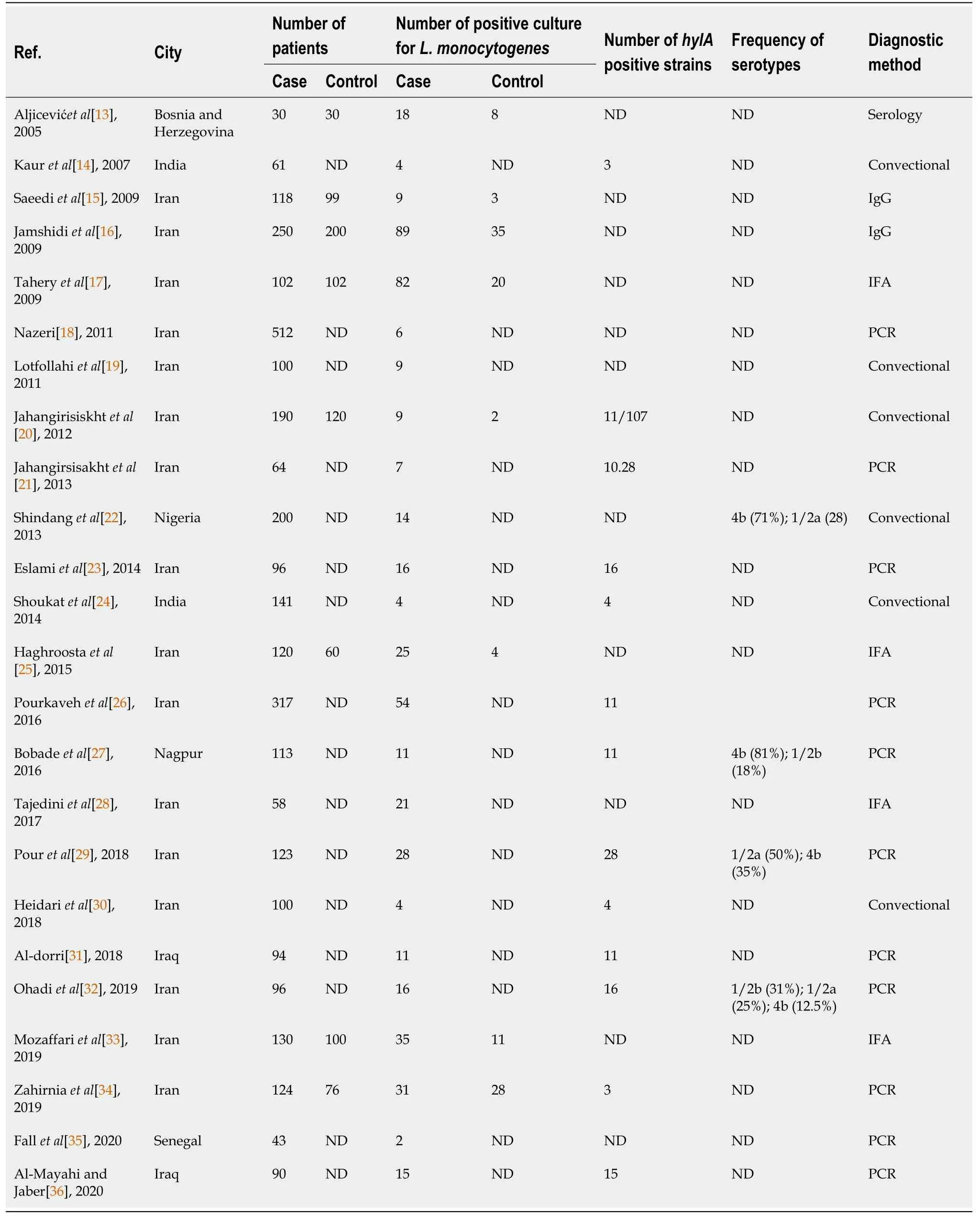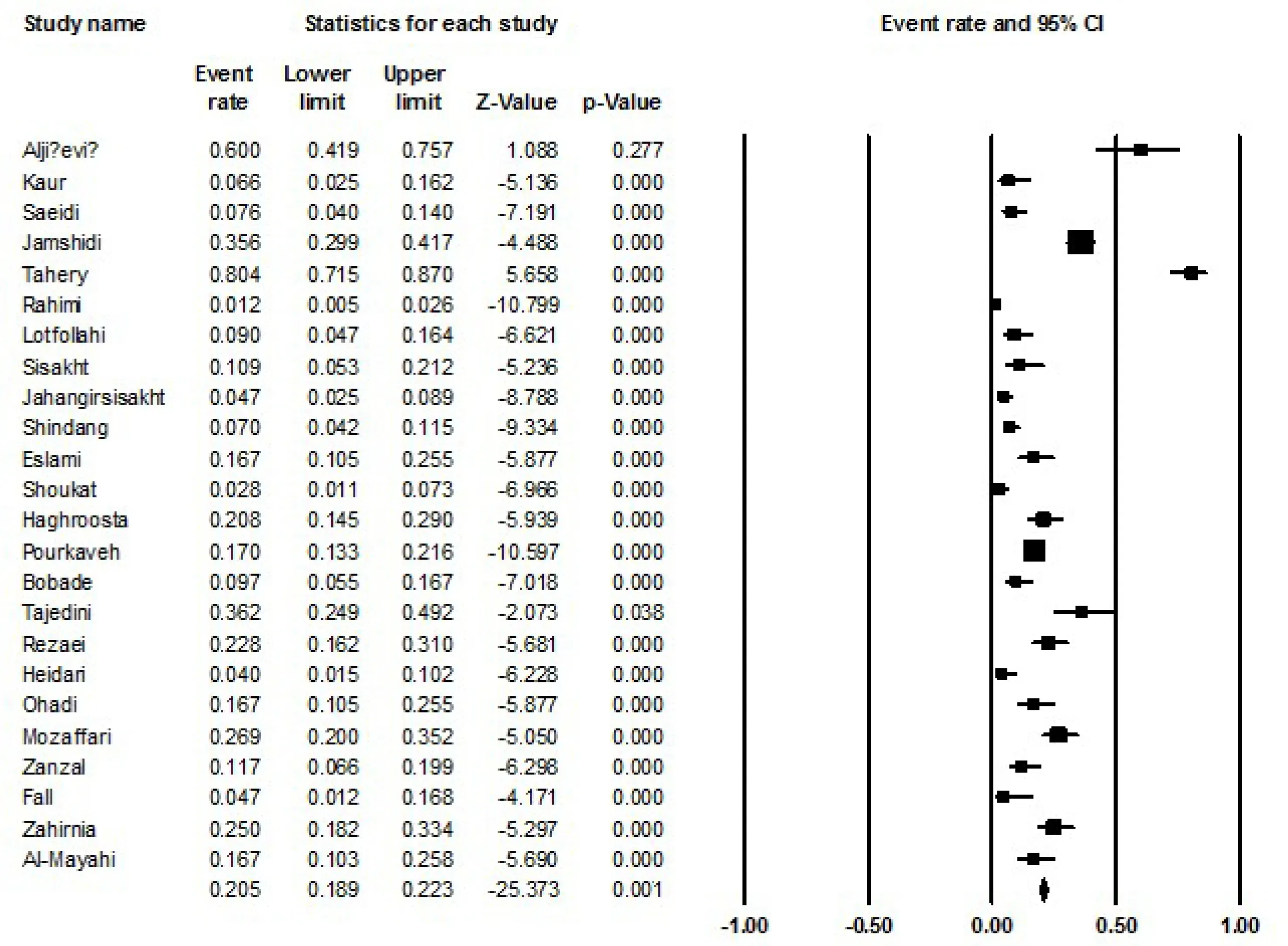Extraintestinal infection of Listeria monocytogenes and susceptibility to spontaneous abortion during pregnancy: A systematic review and meta-analysis
Amir Yousefi, Mohsen Karbalaei, Masoud Keikha
Amir Yousefi, Masoud Keikha, Department of Microbiology and Virology, Faculty of Medicine, Mashhad University of Medical Sciences, Mashhad 1313199137, Iran
Mohsen Karbalaei, Department of Microbiology and Virology, School of Medicine, Jiroft University of Medical Sciences, Jiroft 1313199137, Iran
Abstract BACKGROUND Listeria monocytogenes (L.monocytogenes) is one of the most important zoonotic bacteria that is transmitted to humans through infected animal products and is the cause of human listeriosis.Pregnant women and immunocompromised patients are more susceptible to the bacterium than healthy people.Recent studies have reported extensive evidence on the role of L.monocytogenes infection and the risk of spontaneous abortion.AIM To evaluate the possible connection with L.monocytogenes in the risk of spontaneous abortion in pregnancy.METHODS We conducted a systematic literature review using several databases to search the relevant case-control studies on the association between L.monocytogenes infection and spontaneous abortion.Finally, the impact of infection with L.monocytogenes and risk of spontaneous abortion was assessed via odds ratio at corresponding 95% confidence intervals.RESULTS In the present study, we evaluated the data of 4059 pregnant women who had a spontaneous abortion, and interestingly their colonization rate of L.monocytogenes was about 20.5%.CONCLUSION Therefore, based on statistical analysis, we found that there is a significant relationship between the infection with L.monocytogenes and spontaneous abortion.
Key Words: Listeria monocytogenes; Meta-analysis; Pregnancy; Spontaneous abortion; Women
INTRODUCTION
Spontaneous abortion is one of the biggest health challenges that has increased in recent decades, especially due toin vitrofertilization methods, such asin vitrofertilization, gamete intrafallopian transfer, and intracytoplasmic sperm injection[1].About 1% of women suffer from recurrent miscarriage, so this phenomenon can be considered a serious threat to population decline[1,2].The prevalence of spontaneous abortion in the world is reported to be 10%-20%, and many factors such as blood type, ectopic pregnancy, smoking, obesity, history of cesarean section, fertility treatment, and infectious pathogens are involved in its occurrence[3,4].According to the literature, several infectious microorganisms such asChlamydia trachomatis,Ureaplasma urealyticum,Mycoplasma hominis,Listeria monocytogenes(L.monocytogenes), herpes simplex viruses, adenoviruses, human polyomaviruses, and cytomegalovirus play an important role in individual susceptibility to spontaneous abortion[5,6].
L.monocytogenesis a gram-positive, non-spore forming, facultative anaerobe, and motile bacterium that naturally resides in sources such as water, soil, vegetables, dairy products, and processed food[7].These bacteria enter the human body through the fecal-oral route and can withstand harsh environmental conditions such as acidic pH, high salt concentration, and low temperature[8].This bacterium can cross the intestinal barrier and enter various tissues through hematogenous dissemination, particularly the placenta-fetal unit and the cerebrospinal fluid[9,10].Studies show that pregnant women are about 17 times more likely to be infected withL.monocytogenesthan the general population[11].Numerous studies have been performed on the effects of infection ofL.monocytogenesand abortion in humans and animals[12].The aim of this study was to investigate the effects of extraintestinal infection with this pathogen and susceptibility to spontaneous abortion.We estimated the frequency ofL.monocytogenescolonization in the women who had a spontaneous miscarriage.
MATERIALS AND METHODS
Search strategy and study selection
Initially, a systematic search of global dat abases such as PubMed, Scopus, Google Scholar, and SID was conducted to collect all articles on the effects ofL.monocytogenesinfection on spontaneous abortion, regardless of publication date or language restrictions.Search terms were selected based on Medical Subject Headings browser including “Listeria monocytogenes,” “Spontaneous abortion,” “Pregnant women,” and “Pregnancy.” Articles published in Persian, Arabic, and English were the only articles evaluated.After reviewing the titles and abstracts of eligible original articles (casecontrol studies, cross-sectional, and longitudinal studies), we selected those studies that were related to the effect ofL.monocytogenesinfection on spontaneous abortion.The process of searching and evaluating articles was done by two authors independently, and the discrepancies were examined by the third author.Duplicate articles, insufficient and vague information, case reports, and review articles were excluded from the study (Figure 1).
Data extraction and quality assessment
The required information such as first author, publicatio n year, country, number of cases with at least one spontaneous abortion, number ofL.monocytogenesstrains, frequency ofhlyAgene, frequency of serotypes, diagnostic methods, and the reference number were extracted from the eligible studies and are presented in Table 1.An important evaluation checklist of the Joanna Briggs Institute was used to evaluate the quality of the studies in the present meta-analysis.
Statistical analysis
The comprehensive meta-analysis software ver 2.0 (Biostat, Englewood, NJ, United States) was used for data pooling as well as statistical analysis of the extracted data.The frequency ofL.monocytogenesinfection in women with spontaneous abortion was measured as the incidence rate (event rate) with 95% confidence intervals (CIs) using cross-sectional and case-control studies.In addition, the frequency of thehlyAgene as well as common serotypes isolated from women with spontaneous abortion were also examined as the incidence rate.The effect of infection with this bacterium on the susceptibility to spontaneous abortion was assessed according to odds ratio with the 95%CIs using eligible case-control studies.Finally, the frequency of resistance ofL.monocytogenesstrains to different antibiotics was calculated and reported as the incidence rate and heterogeneity between studies was determined usingI2index and Cochran’sQ-test.In cases with high heterogeneity (I2> 25% and Cochran’sQ-testP> 0.05), the analysis was done using the random-effects model.The publication bias was also determined using Egger’sPvalue, Begg’sPvalue, and asymmetry of funnel plots.
RESULTS
Characteristics of eligible studies
Of the 732 initial studies collected, 24 studies were eligible and entered in our metaanalysis (Figure 1)[13-36].Of these, 17 studies were conducted in Iran, 2 studies in India, 2 studies in Iraq, 1 study in Bosnia and Herzegovina, 1 study in Nigeria, 1 study in Nagpur, and 1 study in Senegal.Overall, in selected studiesL.monocytogenes(strains were isolated from urine, blood, placenta, vaginal swabs, and cervix swabs).In general, microbiological methods such as cold-enrichment, culture on PALCAM agar, culture on blood agar, as well as Gram-staining, oxidase, catalase, carbohydrates fermentation, methyl red/Voges-Proskauer, and motility at 25 °C were used to isolate and identifyL.monocytogenesstrains.In addition, the authors had used polymerase chain reaction technique (for genes such ashlyA,InlA,InlB,actA,iap,plcA, andPrfA) and serological tests on blood samples in their studies (Table 1).
Statistical analysis of spontaneous abortion
The prevalence ofL.monocytogenesinfection in women undergoing spontaneous abortion was approximately 20.5% (18.9-22.3 with 95%CIs;P= 0.001;I2: 93.85;Q-value: 374.16;P= 0.001; Egger’sP= 0.05; Begg’sP= 0.01) was estimated (Figure 2).
The frequency of thehlyAgene inL.monocytogenesstrains isolated from patients was estimated to be about 28.0% (21.0%-36.3% with 95%CI;P= 0.001;I2: 87.34;Q-value: 94.84;P= 0.001; Begg’sP= 0.03; Egger’sP= 0.001).Also, abundance of serotypes 1/2a, 12/b, and 4b were measured to be about 38.7% (26.8%-52.2% with 95%CIs), 26.5% (13.1%-46.3% with 95%CIs), and 49.5% (32.8%-59.5% with 95%CIs), respectively.
Furthermore, it was revealed that the infection withL.monocytogenessignificantly increases the risk of spontaneous abortion in pregnant women (odds ratio: 2.778; 2.130-3.623 with 95%CIs;P= 0.001;I2: 76.30;Q-Value: 21.01;P= 0.001; Egger’sP= 0.38; Begg’sP= 0.51) (Figure 3).
Statistical analysis of antibiotic resistance
The current analysis showed thatL.monocytogenesstrains isolated from spontaneous abortion cases were resistant to various antibiotics.The resistance to different antibiotics was as follows: ampicillin 31.8% (25.5-38.9 with 95%CIs;I2: 92.96;Q-Value: 56.84;P= 0.001), penicillin G 56.8% (51.4-62.0 with 95%CIs;I2: 94.64; Q-Value: 74.67;P= 0.001), cotrimoxazole 33.0% (24.5-42.8 with 95%CIs;I2: 0.00;Q-Value: 0.00;P= 1.00), cephalothin 50.0% (40.3-59.7 with 95%CIs;I2: 0.00;Q-Value: 0.00;P= 1.00), tetracycline 29.2% (23.2-36.1 with 95%CIs;I2: 91.75;Q-Value: 36.37;P= 0.001), erythromycin 15.0% (9.5-22.8 with 95%CIs;I2: 91.96;Q-Value: 37.31 ;P= 0.001), cefotaxime 77.0% (70.7-82.3 with 95%CIs;I2: 0.00;Q-Value: 0.00;P= 1.00), chloramphenicol 11.0% (7.4-16.1 with 95 % CIs;I2: 0.00;Q-Value: 0.00;P= 1.00), trimethoprim 38.3% (30.5-46.8 with 95%CIs;I2: 95.47;Q-Value: 66.26;P= 0.01), ciprofloxacin 11.1% (6.8-17.7 with 95%CIs;I2: 82.1;QValue: 11.18;P= 0.04), gentamycin 28.0% (20.0-37.6 with 95%CIs;I2: 0.00;Q-Value: 0.00;P= 1.00), and streptomycin 11.0% (7.4-16.1 with 95%CIs;I2: 0.00;Q-Value: 000;P= 1.00).No resistance has been reported to the three antibiotics amikacin, meropenem, and norfloxacin.

Table 1 Characteristics of included studies

Figure 1 Flowchart of search strategy and study selection.

Figure 2 Forest plot for frequency of infection with Listeria monocytogenes among spontaneous abortion cases.

Figure 3 Forest plot for relationship between Listeria monocytogenes infection and susceptibility to spontaneous abortion.
DISCUSSION
Listeriosis is one of the most well-known foodborne diseases that is transmitted to humans through the consumption of contaminated animal products.Several outbreaks of listeriosis have been reported worldwide, with children being the main victims[37].According to studies, the prevalence of listeriosisper100000 people in children, the elderly, and pregnant women is estimated at 3.4, 10.0, and 12.0, respectively.Pregnant women can pass listeriosis to their baby in the womb or at birth[38].Latent listeriosis in pregnant women can have fatal effects on the fetus such as granulomatosis infantiseptica, spontaneous abortion, stillbirth, premature birth, and meningitis[39].According to the Centers for Disease Control and Prevention, about 14% of human listeriosis occurs in pregnant women.Therefore, the diagnosis of listeriosis during pregnancy is essential, especially in developing areas (Listeriaspp.are more likely to be contaminating food in these areas)[40].
Based on the current analysis, it was shown that the rate of colonization withL.monocytogenesin women who had spontaneous abortions was about 20.5%, although in some studies,L.ivanoviiandL.seeligeriwere the cause of infection and abortion.For the first time, in the current meta-analysis, we evaluated the association of colonization withL.monocytogenesin pregnant women with spontaneous abortion, and most of the studies considered in the current analysis were related to Iran.Iran as a developing country has a high rate ofL.monocytogenesinfection, which in turn is related to working conditions, lifestyle, and geographical location.In another meta-analysis study from Iran, the rate of colonization withL.monocytogenesin humans, animals, and food products was estimated at 10%, 7%, and 4%, respectively[41].
Cell-mediated immunity is somewhat suppressed during pregnancy, while humoral immunity is as active as ever.Therefore, pregnancy increases the risk of infection with facultative intracellular bacteria such asL.monocytogenes.Meanwhile, the human placenta also provides a protective niche for the growth and proliferation of this bacterium, which in turn increases the risk of spontaneous abortion[42].We found that infection withL.monocytogenescan significantly increase the risk of miscarriage during pregnancy (odds ratio: 2.7; 2.1-3.6 with 95%CI;P= 0.01).
So far, four lineages have been identified fromL.monocytogenesstrains, and it should be noted that lineages I (serotypes 1/2b and 4b) and II (1/2a) are responsible for most human infections.In this study, the frequencies of serotypes 1/2a, 1/2b, and 4b were reported as 38.7%, 26.5%, and 49.5%, respectively, which were similar to the distribution of serotypes in other human listeriosis infections[27,29].In pathogenic strains, numerous virulence factors are encoded by pathogenicity island 1.ThehlyAgene encodes hemolysin (listeriolysin-O), which is one of the most important virulence factors ofL.monocytogenes[43].According to our analysis, only 28% of strains isolated from women with spontaneous miscarriage had this gene, indicating the low diagnostic value of this gene for diagnosis ofL.monocytogenesinfection in pregnant women.
Based on the evidence, β-lactam antibiotics alone or in combination with aminoglycosides as well as cotrimoxazole are recommended treatment options for severe listeriosis infections.Although, nowadays, the resistance ofListeriaspp.to β-lactams and aminoglycosides is increasing[44,45].SomeL.monocytogenesstrains are also resistant to other antibiotics such as fluoroquinolones, macrolides, and tetracyclines, and the emergence and spread of the drug-resistant strains in pregnant women can be life-threatening for both mother and child[44].Our results showed that the antibiotic resistance ofL.monocytogenesstrains isolated from the women with spontaneous abortion was high.The highest resistance was related to cefotaxime (77%), and the lowest was related to chloramphenicol and streptomycin (both 11%); all strains were sensitive to norfloxacin, meropenem, and amikacin.In a recent meta-analysis study by Khademi and Sahebkar[44], resistance ofL.monocytogenesstrains isolated from Iranian patients to penicillin, ampicillin, and gentamicin was reported to be 56.8%, 29.5%, and 32.4%, respectively, which was close to the results of our study[44].Quentinet al[46] also identified a multi-resistant strain ofL.monocytogenesin a septic abortion[46].It is important to note that increasing drug resistance ofL.monocytogenesstrains to βlactams and aminoglycosides in the coming years will lead to the ineffectiveness of these antibiotics in the treatment of human listeriosis.
Our meta-analysis has several limitations as following: (1) The population sample size was low; (2) Heterogeneity was significant; (3) There is a slight publication bias; and (4) We included only available articles in Persian, Arabic, and English.Overall, our results showed that there is a significant relationship betweenL.monocytogenesinfection and the increased risk of miscarriage during pregnancy.The results of the present analysis also showed that drug resistance is increasing amongL.monocytogenesstrains, which needs to be re-evaluate.If necessary, treatment guidelines should be updated to reduce the incidence of human listeriosis.
CONCLUSION
Overall, regarding the importance of microorganisms such asChlamydia trachomatis, Ureaplasma urealyticum, Mycoplasma hominis, L.monocytogenes, herpes simplex viruses, adenoviruses, human polyomaviruses, and cytomegalovirus in the induction of spontaneous abortion, it is important that all aspects of these pathogens, such as diagnosis, treatment, control, and vaccination, be considered by all researchers around the world.
ARTICLE HIGHLIGHTS
Research background
Spontaneous abortion is one of the most important concerning issues in pregnant women, and it has been suggested that Listeria monocytogenes (L.monocytogenes)infection can play a key role in pathogenesis of this disease.
Research motivation
We conducted the present study to estimate the risk of infection with L.monocytogenes in the development of spontaneous abortion during pregnancy.
Research objectives
The aim of this study was evaluation of the probable connection between infection with L.monocytogenes and risk of spontaneous abortion in pregnancy.
Research methods
We conducted a systematic literature review using several databases to search the relevant case-control studies on the association between L.monocytogenes infection and spontaneous abortion.Finally, the impact of infection with L.monocytogenes and risk of spontaneous abortion was assessed via odds ratio at corresponding 95% confidence intervals.
Research results
The frequency of L.monocytogenes infection was significantly increased in pregnant women with spontaneous abortion in comparison with healthy subjects.There is significant association between infection with L.monocytogenes and development of spontaneous abortion in pregnant women (odds ratio: 2.778; 2.130-3.623 with 95%confidence interval).
Research conclusions
Our results suggested the infection withL.monocytogenesis a marker for prediction of the risk of development of spontaneous abortion during pregnancy.
Research perspectives
Regarding the importance ofL.monocytogenesin the initiation and development of spontaneous abortion, it is important that all aspects of this pathogen, such as diagnosis, treatment, control, and vaccination, be considered by all researchers around the world.
 World Journal of Meta-Analysis2021年3期
World Journal of Meta-Analysis2021年3期
- World Journal of Meta-Analysis的其它文章
- Post COVID-19 infection: Long-term effects on liver and kidneys
- Immune response to Helicobacter pylori infection and gastric cancer development
- Dengue hemorrhagic fever and cardiac involvement
- Glycated haemoglobin reduction and fixed ratio combinations of analogue basal insulin and glucagon-like peptide-1 receptor agonists: A systematic review
- Impact of Streptococcus pyogenes infection in susceptibility to psoriasis: A systematic review and meta-analysis
